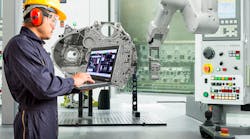Manufacturers have a lot of data from many areas of their organizations, except for the supply side. That makes it difficult to craft a balanced capacity plan because these organizations are missing critical signals. But, when they solve that challenge, they have a complete signal chain of supply and demand data that can be combined with external and historical data to power a “decisioning” platform and optimize their entire operation.
Manufacturers have too much data
Manufacturers hear a lot about digital transformation and modernization. But, from what I see, that was yesterday's challenge. What manufacturers struggle with now is trusting what the data tells them and then putting that digitized data to use, to increase operational productivity and power the strategic engine of growth.
On the sales side of their business, leaders have long trusted and relied on what their customer relationship management (CRM) system has revealed. Add in more insights from marketing, production, supply-chain management, and other data sources and those demand signals are current, easy to capture, and easy to convert into action.
Signals from the supply side, however, have always been a bit less clear — and less timely. Couple that with continuing global supply chain issues and a still-in-process pandemic rebound, and the sales and operations planning (S&OP) process becomes a guessing game at best.
It’s bits versus boxes: The demand side is largely automated and flush with digital bits. The supply side is still very physical, with the most reliable information coming from someone seeing the boxes as they’re loaded onto a truck.
So how can manufacturers solve this disconnect in the manufacturing signal chain?
Listen for signals
First, manufacturers need to capture more data from suppliers in near real-time and be able to respond when issues arise. Then, combine that with more data from more sides of the manufacturing business, and add in years of historical financial, market, and customer data to complete the signal chain. This includes data streaming in from the other departments and systems necessary to run a modern manufacturing business: order management, engineering, inventory, field service, etc.
Finally, use that signal chain to dynamically balance the planning of available capacity to fill the dynamically changing demand, while simultaneously mitigating supply uncertainty.
This balancing act clearly requires advanced levels of data aggregation, data analysis, and decision-making that can only come from a data science infrastructure that can handle streaming data, which few manufacturers have. A more reasonable solution is a decisioning platform.
A “decisioning” platform
A decisioning platform uses incoming supply and demand data from across the manufacturing signal chain to automate and augment decision-making, using artificial intelligence (AI) to improve and optimize all aspects of production operations. Here are a few examples of how this works:
- Customers increase, decrease, and cancel orders every day while capacity planning happens weeks or months ahead of time. When changes occur, a manufacturer is forced to delay orders, expedite shipments, hold excess inventory, idle workers, or worse. A decisioning platform uses the manufacturer’s signal chain to synchronize operations in real-time and maintain that delicate demand-capacity-supply balancing act.
- Accurate forecasting is critical to S&OP optimization. Demand signals only tell part of the story. Adding in market trends, seasonality, and other factors and letting AI spot what’s relevant across millions of data points creates more accurate, dependable forecasts. A decisioning platform then helps manufacturers optimize production schedules and ensure supplies are on-hand when needed.
- Minimizing lead times improves manufacturing agility and increases cashflow. AI can tease out potential bottlenecks in the supply chain, giving the decisioning platform more intelligence to improve lead times.
Connect the manufacturing signal chain
For most manufacturers, the signal chain is incomplete. The demand side is robust, but the supply side is not. Even more, a reliance on spreadsheets not only creates problems (human error, siloed data, slow processes, etc.), it leaves organizations unable to capture, analyze, and understand massive amounts of data in time to respond effectively. Typically, the “response” is more reactive.
Digitizing the supply side of a manufacturer’s operations with a cloud ERP is the first step, but it’s also a great opportunity to deploy a decisioning platform that can act as the single source for S&OP intelligence. Adding historical trends, financial, and other data gives AI the power to provide predictive insights that manufacturers can use to optimize all aspects of operations.
Manufacturers can justify the investment in a decisioning platform by focusing on the financial impact. The manufacturing signal chain can inform massive decisions, such as substantiating the need for facility expansions, equipment purchases, and other investments in growth. AI can improve those decisions by giving manufacturers the decisioning capabilities they need—this would provide more insights than a team equipped spreadsheets could glean.
Also, manufacturers cannot forget the day-to-day impact of a decisioning platform. Worker absenteeism, unplanned downtime, weather, traffic, current events, and other disruptions all weigh on S&OP process and sap productivity and profitability. AI can sift through the noise, tune in to the relevant signals, identify trends not otherwise visible, and ensure manufacturers are always acting on the best information.
Ultimately, manufacturers want complete signals to get into the hands of their planners so they can make better decisions. Digital transformation has set the stage. Now, a decisioning platform will help them call the best plays for their operational team to act upon.
Stu Johnson is vice president of product marketing at Rootstock Software. Contact him via LinkedIn.






